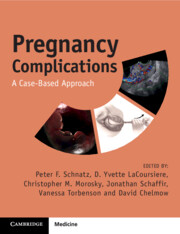Book contents
- Pregnancy Complications
- Pregnancy Complications
- Copyright page
- Contents
- Contributors
- Preface
- Note from the Editor-in-Chief
- Normal Laboratory Values (Conventional Units) []
- Section 1 Antepartum (Early Pregnancy)
- Section 2 Antepartum (Mid-trimester)
- Section 3 Antepartum (Late Pregnancy)
- Case 20 A Patient with Regular Painful Uterine Contractions at 32 Weeks
- Case 21 A 25-Year-Old Presents at 22 Weeks’ Gestation Leaking Clear Fluid
- Case 22 A 40-Year-Old at 34 Weeks’Gestation with Worsening Itching
- Case 23 A 25-Year-Old Presents at 30 Weeks’ Gestation Following a Motor Vehicle Accident
- Case 24 A 20-Year-Old Presents at 34 Weeks’ Gestation with Pruritic Abdominal Rash
- Case 25 A 30-Year-Old Presents at 18 Weeks’ Gestation with Severe Right Back and Flank Pain
- Case 26 A 30-Year-Old at 18 Weeks’ Gestation with Fever, Dysuria, Worsening Flank Pain, and Hydronephrosis
- Case 27 A 35-Year-Old with Abdominal Wall Bulge at 24 Weeks’ Gestation
- Case 28 A 30-Year-Old Presents for a Prenatal Visit at 41 Weeks’ Gestation
- Case 29 A 40-Year-Old Presents at 34 Weeks’ Gestation with Absent Fetal Movement
- Case 30 A 25-Year-Old at 36 Weeks’ Gestation Presents with Severe Bilateral Wrist Pain
- Case 31 A 20-Year-Old Presents at 31 Weeks’ Gestation with Severe Abdominal Pain and Constipation
- Section 4 Antepartum (Medical Complications)
- Section 5 Antepartum (Infectious Complications)
- Section 6 Intrapartum/Delivery
- Section 7 Postpartum
- Section 8 Fetal Complications
- Section 9 Placental Complications
- Section 10 Complications of the Cord, Amnion, and Gravid Uterus
- Section 11 Psychosocial Considerations
- Index
- References
Case 30 - A 25-Year-Old at 36 Weeks’ Gestation Presents with Severe Bilateral Wrist Pain
from Section 3 - Antepartum (Late Pregnancy)
Published online by Cambridge University Press: 08 April 2025
- Pregnancy Complications
- Pregnancy Complications
- Copyright page
- Contents
- Contributors
- Preface
- Note from the Editor-in-Chief
- Normal Laboratory Values (Conventional Units) []
- Section 1 Antepartum (Early Pregnancy)
- Section 2 Antepartum (Mid-trimester)
- Section 3 Antepartum (Late Pregnancy)
- Case 20 A Patient with Regular Painful Uterine Contractions at 32 Weeks
- Case 21 A 25-Year-Old Presents at 22 Weeks’ Gestation Leaking Clear Fluid
- Case 22 A 40-Year-Old at 34 Weeks’Gestation with Worsening Itching
- Case 23 A 25-Year-Old Presents at 30 Weeks’ Gestation Following a Motor Vehicle Accident
- Case 24 A 20-Year-Old Presents at 34 Weeks’ Gestation with Pruritic Abdominal Rash
- Case 25 A 30-Year-Old Presents at 18 Weeks’ Gestation with Severe Right Back and Flank Pain
- Case 26 A 30-Year-Old at 18 Weeks’ Gestation with Fever, Dysuria, Worsening Flank Pain, and Hydronephrosis
- Case 27 A 35-Year-Old with Abdominal Wall Bulge at 24 Weeks’ Gestation
- Case 28 A 30-Year-Old Presents for a Prenatal Visit at 41 Weeks’ Gestation
- Case 29 A 40-Year-Old Presents at 34 Weeks’ Gestation with Absent Fetal Movement
- Case 30 A 25-Year-Old at 36 Weeks’ Gestation Presents with Severe Bilateral Wrist Pain
- Case 31 A 20-Year-Old Presents at 31 Weeks’ Gestation with Severe Abdominal Pain and Constipation
- Section 4 Antepartum (Medical Complications)
- Section 5 Antepartum (Infectious Complications)
- Section 6 Intrapartum/Delivery
- Section 7 Postpartum
- Section 8 Fetal Complications
- Section 9 Placental Complications
- Section 10 Complications of the Cord, Amnion, and Gravid Uterus
- Section 11 Psychosocial Considerations
- Index
- References
Summary
Carpal tunnel syndrome (CTS) is a neuropathy of the median nerve that occurs due to compression of the nerve in the carpel tunnel. Pregnancy is a risk factor for the development of CTS. Reported prevalence in pregnancy varies widely depending on the diagnostic criteria utilized, with prevalence ranging from 2 to 62%, with the most common time for presentation in pregnancy during the third trimester. Typical symptoms include tingling and pain in the thumbs, index, and middle fingers. Most pregnant patients with carpal tunnel syndrome will present with mild symptoms and minimal functional impairment, though sleep quality can be impacted. Conservative management with physical therapy and splinting will typically be sufficient. Local steroid injections are safe and effective for more significant symptoms or those that do not improve with conservative measures. Surgery for CTS during pregnancy is reserved for severe cases, or those with evidence of median nerve denervation.
- Type
- Chapter
- Information
- Pregnancy ComplicationsA Case-Based Approach, pp. 92 - 93Publisher: Cambridge University PressPrint publication year: 2025

